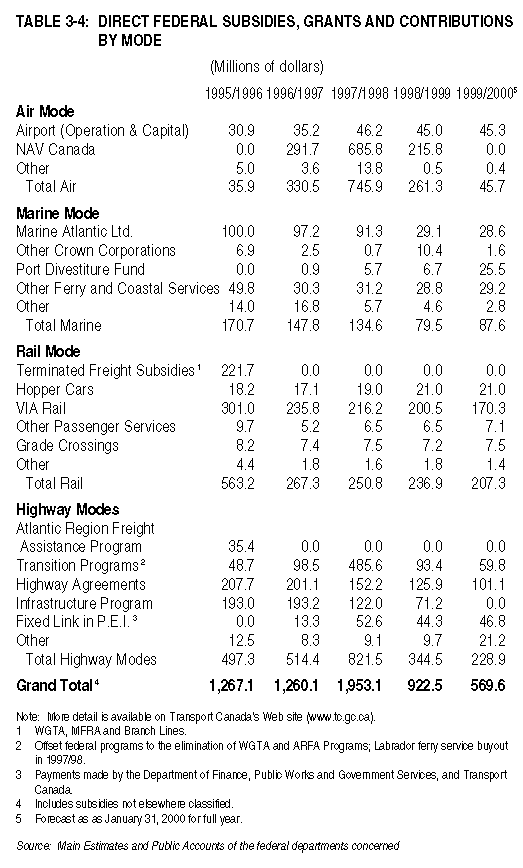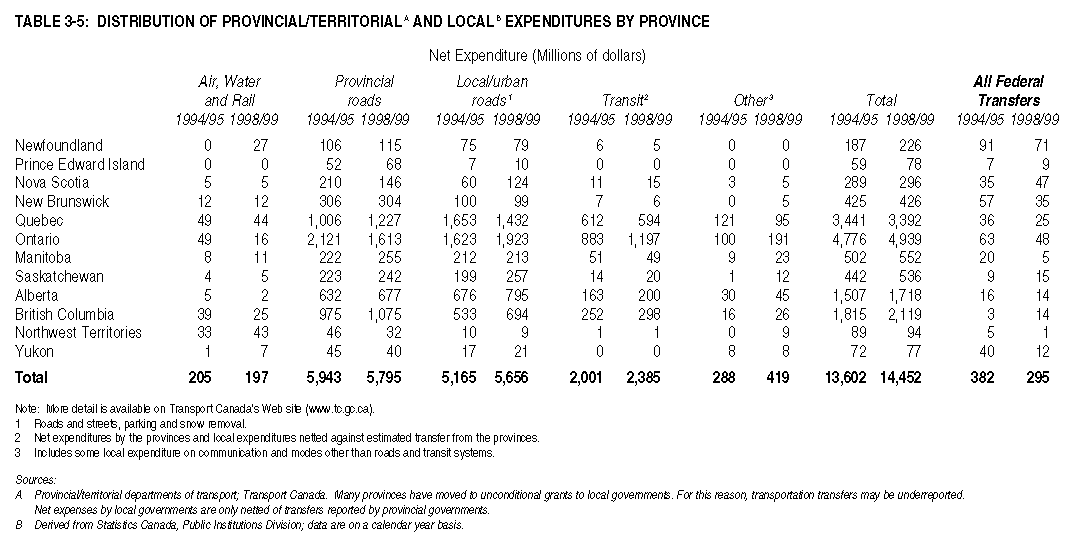3
GOVERNMENT SPENDING ON TRANSPORTATION
Government spending on transportation
has declined over the past five years
at the federal and provincial/territorial levels, while it continues
to increase on the local scene.
However, Transport Canada's shift toward a policy and safety orientation,
as well as divestiture and commercialization initiatives, has
affected
both expenses and revenues.
Introduction
This chapter describes the transportation expenditures and
revenues of all three levels of government - federal,
provincial/territorial and local. Where possible, expenditures
and revenues are subdivided by mode.
The chapter begins by summarizing all transportation expenditures
and revenues by levels of government. It then gives a synopsis
of federal and provincial revenues from transportation users,
followed by a detailed examination of consolidated expenditure
by mode. Finally, it presents provincial/territorial and local
government transportation expenditures.
Government Transportation Expenditures
This section covers spending on transportation by all levels
of government and their agencies. Net expenditures are derived
after taking into account the federal government revenues (other
than fuel taxes) attributable to transportation users and government
transfers received from other levels of government.
Table 3-1 shows that, over the past several years, total government
net expenditures on transportation have consistently been in the
$16-17 billion range. While the federal and provincial/territorial
levels show no apparent pattern, the local government expenditures
show a definite increase. From 1994/95 to 1998/99, net expenditures
on transportation by local governments have increased, on average,
by almost 2.5 per cent a year. Expenses by the provinces and territories
increased by nine per cent in 1998/99, returning to the levels
of the early 1990s.

Over the 1994/95 to 1998/99 period, net federal government
expenses on transportation have been halved. Gross expenses by
Transport Canada have been reduced by 52 per cent. Revenues dropped
by 36 per cent, as a result of the divestiture of some airports
and the elimination of the Air Transportation Tax (ATT) and other
navigation fees from the federal government books. Prior to the
airports being devolved, total revenues are included, while afterwards,
only the lease payments to Transport Canada are shown. Other federal
departments and agencies that have transport-related expenses
include the Canadian Transportation Agency, the Civil Aviation
Tribunal, Fisheries and Oceans Canada, Public Works and Government
Services Canada, Heritage Canada (Parks Canada), the National
Capital Commission, and Indian and Northern Affairs Canada. The
transfers to Agriculture Canada of the adjustment for the elimination
of the Western Grain Transportation Act (WGTA) subsidy,
Treasury Board's infrastructure programs, and Public Works and
Government Services Canada's Northumberland Strait Crossing are
reflected in total expenditures by other federal agencies and
departments. Over the period, gross transport expenses by all
federal departments/agencies, other than Transport Canada, have
fallen by 30 per cent.
Net expenditures on transportation by all levels of government
in 1998/99 increased by $97 million, or 0.6 per cent,
over the previous year's level. Both provincial and local governments
showed an increase, while net transport expenses by the federal
government fell by 33 per cent. Federal net transport
expenses in 1999/2000 are expected to fall by $48 million, or
three per cent.
The reduced share of federal expenditures recovered (20.8 per
cent in 1999/2000 compared with 30.5 per cent in 1998/99) is tied
to divestitures and commercialization initiatives. Former federal
cost recovery responsibilities are now assumed by new entities.
Total Transportation Revenues by Level of Government
The federal government obtains revenues from the use of transportation
facilities and services. Revenues from cost recovery are credited
to a federal department's budget, while other revenues are credited
to the government's Consolidated Revenue Fund. Both are included
in this analysis. Excise fuel taxes collected by the federal and
provincial governments, as well as provincial licence and other
fees, constitute tax revenues collected from transport users.
They are reported in Table 3-2.

In 1999/2000, federal government transport revenues, other
than fuel taxes, are forecast to total $404 million, down from
$700 million in the previous year and $1.0 billion in 1997/98.
Most revenues originate from airport lease revenues, which
should reach $263 million. Marine fees are to bring in an
additional $79 million.
The Air Transportation Tax (ATT) has not been credited to Transport
Canada since 1996/97, but is included here because its proceeds
were subsequently transferred to NAV Canada to finance its
operations. The sunsetting of the ATT is responsible for
the substantial revenue reduction in 1999/2000. Other revenues
not credited to Transport Canada, such as those from the leases
of hopper cars or the sale of port assets, are also reported
in Table 3-2.
In 1998/99, revenues collected from transport users as fuel
taxes, and permit and licence fees by the provincial/ territorial
governments, totalled $14 billion, an increase of 3.7 per
cent over 1997/98. By far the largest component is fuel taxes,
averaging 78 per cent of total government annual revenues from
transportation from 1994/95 to 1998/99. Over the same period,
the annual growth rate of fuel tax revenues and of licence
and permit revenues was comparable.
Federal Expenses Related to Transport Facilities and Services
The federal government provides transportation facilities and
services in all modes. As shown in Table 3-3, these include airports,
port and harbour operations, modal safety and policy services,
and services provided by the Canadian Coast Guard (now part of
the Department of Fisheries and Oceans). The federal government
also performs several multimodal activities, including the investigation
of accidents and the regulation and monitoring of the transport
of dangerous goods.

Between 1996/97 and 1998/99, direct federal transport expenses
fell from $2.2 billion to $1.4 billion. The transfer of the operations
of the Air Navigation System (ANS) to NAV Canada accounts for
65 per cent of the decline. In 1999/2000, the operating and
capital expenses of the federal government in transport are forecast
to increase by 0.6 per cent from the 1998/99 levels.
The Canadian Coast Guard now represents the largest single
federal transport expense ($514 million by 1999/2000). The costs
of operating federal ports and airports should reach $224 million
by 1999/2000, down from $489 million in 1996/97. This reflects
divestiture initiatives. Expenditure on safety and policy are
forecast to reach $303 million by 1999/2000, up from $249 million
in 1996/97, in accord with Transport Canada's increased orientation
to a policy and safety role. Direct expenses on roads are forecast
to fall from $175 million in 1996/97 to $148 million in 1999/2000.
Federal Subsidies to Transportation
Total direct federal subsidies, grants and contributions in
1999/2000 are projected to be $570 million, 38 per cent less than
in 1998/99. This major reduction can be explained by the elimination
of payments to NAV Canada and by the decline in highway transfers
as transition and infrastructure programs are finishing. Since
1995/96, subsidies and transfers have fallen by more than 50 per cent.
Subsidies to freight transport and ferry operations were either
eliminated or substantially reduced. Highway transfers were also
reduced. Table 3-4 gives more detail.

Distribution of Provincial/Territorial and Local Expenditure
by Province
In 1998/99, provincial/territorial and local governments' spending
on transportation amounted to $14.5 billion. This was a 6.6 per
cent increase from 1997/98 and reversed two consecutive years
of decline. The 1998/99 spending levels are higher than in 1995/96.
Figure 3-1 illustrates the trends in provincial and local transport
expenses from 1994/95 to 1998/99. Table 3-5 also gives more details.


Since 1994/95, transport spending by provincial and local governments
has increased by 6.3 per cent. The largest increases were recorded
in Prince Edward Island, Saskatchewan and Newfoundland. Expenditures
have declined only in Quebec.
Federal transfers are equivalent to 2.7 per cent of transport
spending by local and territorial governments. In 1998/99, Newfoundland
was the province most dependent on federal transfers, which accounted
for more than 24 per cent of its spending on transport.
Table 3-6 shows more data on transport expenditure and revenues
by mode and level of government.
Spending on roads and highways is the most important category
of transport-related expenditure for all provinces, although other
modes are equally important for some. The proportion for
road and highway spending ranged from almost 100 per cent
in Prince Edward Island, to only 44 per cent in the
Northwest Territories, which spends more on air transportation
(38 per cent) because of its remoteness.
Transit spending is the most substantial in Ontario, where
it accounts for 24 per cent of provincial and local transport
expenditures. High levels of spending on transit in Ontario reflect
the settlement of commitments made prior to services realignment.
Expenditures on transit are also significant in Quebec, where
this sector represents 18 per cent of the local and provincial
transport budgets.
Overview of Expenditures and Revenues
by Mode
This section summarizes consolidated federal expenses and revenues
by mode over the 1996/97 to 1999/2000 period. It also shows expenditures
by other levels of government, netted against transfers received
from other levels of government, from 1996/97 to 1998/99.
Table 3-6 gives detailed information on this.

In 1998/99, the air mode accounted for four per cent of gross
spending on transportation, a decline of 57 per cent
since 1996/97. Aviation users contributed the most, 85 per cent,
to government revenues. As a result, net spending in aviation
was only 0.5 per cent of net government transport expenditure
in 1998/99.
Spending in the marine mode is responsible for about five per
cent of government annual transport spending in 1998/99. Since
1996/97, expenses have been reduced by 12 per cent. Revenues
from users were the same in 1998/99 as in 1996/97. However, they
are projected to increase by nine per cent in 1999/2000.
Rail mode spending has fallen by 14 per cent since 1996/97.
In 1998/99, it accounted for only 1.5 per cent of gross government
spending on transportation. While most of the outlays are subsidies,
revenues accrue in large part from the leasing of hopper cars.
Recently, the provinces have reduced their spending on rail transport
to less than $2 million a year.
Total spending on roads and transit systems was close to $14.4
billion in 1998/99, 2.1 per cent more than in 1997/98. Since 1996/97,
the growth has been 2.2 per cent a year. Public expenses
on transit systems have grown at a faster rate, 9.3 per cent,
to reach $2.4 billion in 1998/99. This is one of the few transportation
expenditure components that has shown a regular increase. In 1998/99,
spending on roads and transit systems accounted for nearly 90
per cent of all net government expenditures on transportation.
The federal role in roads and transit systems consists of contribution
to federal-provincial cost shared agreements, overseeing the management
of the Confederation Bridge, and small road programs managed by
federal departments other than Transport Canada; the maintenance
of two Montreal bridges; a safety and policy function; transfer
payments to provincial or local authorities; and small grants/subsidies
to road users. Altogether, these expenses fell to $525 million
in 1998/99, a drop of 48 per cent from the previous year. Expenses
are expected to further fall to $400 million in 1999/2000.
The category "Other" in Table 3-6 includes overhead
expenses by all levels of government expenditures related to multimodal
policy, safety and economic analysis functions, as well as other
activities such as Transport Canada's Security and Emergency Preparedness,
and Research and Development. About four per cent of total net
transport expenses are allocated to this category. Most of the
revenues are recoveries from other departments for the provision
of research projects or from fines and permits issued by Transport
Canada.
|

